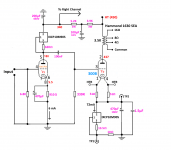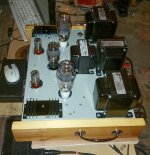300Bs don't come any cheaper than the Chinese Liuzhou version. I ran the amp with these tubes at 1 Khz for an hour at a full 8 Watts with some flattening of the waveform to see how they performed with a 330K grid resistor. I monitored the cathode current carefully throughout and saw no sign of runaway with some grid current, indicated on the 'scope by the shape of the waveform.Definitely with you on preferring CCS on the SN7 over any IST. I get around 0.01% distortion over all signal levels from my SN7 stage, as long as you don't place burden on the stage (as you noted, a CCS and a grid resistor only). Our designs are quite different, but that first stage is critical. In my experience iron does not pair well with the SN7, no matter what I have tried from any manufacturer. Your 300B grids do have capacitance, which doesn't help; an intermediate stage is the ideal solution to that, but is fraught with its own challenges in implementing properly. You may also not require driving the output stage at 5W on a consistent basis, so it's fine as is.
Only been to Kerry once, would love to go back. As one who has lived in Wisconsin (the dairy state) for 40 years, I can attest to Ireland having better dairy.
And Kerry has the best dairy in Ireland with a massive factory, supplying "Kerrygold" butter for the whole of Europe. They love it.
I have now successfully implemented the IXCP10M90S CCS as the plate load for the 6SN7 which drives the 300B. The result is phenomenal. Looks like the theory works out in practice - the dynamic resistance of the IXCP10M90S is certainly around 1MΩ at 6mA. I am using a 330K grid resistor on the 300B (yes, I know I'm living dangerously). This gives the 6SN7 a plate load of 248K - as near as dammit to a straight line.
I've measured the gain of the stage, and it is 19.8 - incredibly close to mu, but the really great aspects to this are the available voltage swing and linearity. I still need to fine-tune the bias and HT. I how have 2 Hammond 126C ISTs for use as doorstops. That was my first experience with ISTs, but I'm not dismissing them altogether - I can't see any need for them in this sort of simple 300B amplifier, now that I have been introduced to the world of Constant Current Sources.
To drive my 300Bs to a theoretical 8 Watts (7 Watts is more realistic), I need about 57 Volts RMS (80V Peak). With a gain of 20, the input to the 6SN7 driver would need to be 2.85 Volts RMS. This is well within the capabilities of all my pre-amps, and so the first half of the 6SN7 is now unused, just wasting heater Watts.
I've drawn out the operating conditions on the 6SN7 curves, and am also including the circuit of my new amplifier version in all its simplicity. It sounds just fine even with cheap Liuzhu 300Bs. Driver stage linearity enables the tonal characteristics of the 300Bs to be heard, without too much driver distortion diluting it.
Many thanks again for all your help everybody.
Looks like it would be a good way to drive a pair of KT88's in PP after a concertina PI (a modification of the Williamson)
I became so enthusiastic about the IXCP10M90S, that I have now replaced the 1K cathode resistor on the 300Bs with this CCS device. I set the Ia to 72 mA and with the voltages shown on the schematic, I can run it to exactly 8 Watts before clipping. The 2 CCSs fit on the underside of the 2.1K/Watt heatsinks which are in the spot where the Hammond 126C interstage transformers once were. I have put in two sets of test points - one for the Ia across a 10 Ohm highly temperature-stable, 0.1% tolerance resistor, and the other monitoring the voltage on the cathode, to determine the grid bias on the 300B. I've listened to it most of the day with JJs at medium volume, and I'm very happy with the way it sounds. The heat sinks are always under 50º C even when the room heats up to about 25.
I can swap in any 300B tube, including my Liuzhous and Golden Dragons, and be guaranteed an Ia of 72mA. But of course, the bias will be different for each type of tube. Some interesting experiments lie ahead.
I can swap in any 300B tube, including my Liuzhous and Golden Dragons, and be guaranteed an Ia of 72mA. But of course, the bias will be different for each type of tube. Some interesting experiments lie ahead.
Attachments
- Status
- This old topic is closed. If you want to reopen this topic, contact a moderator using the "Report Post" button.

